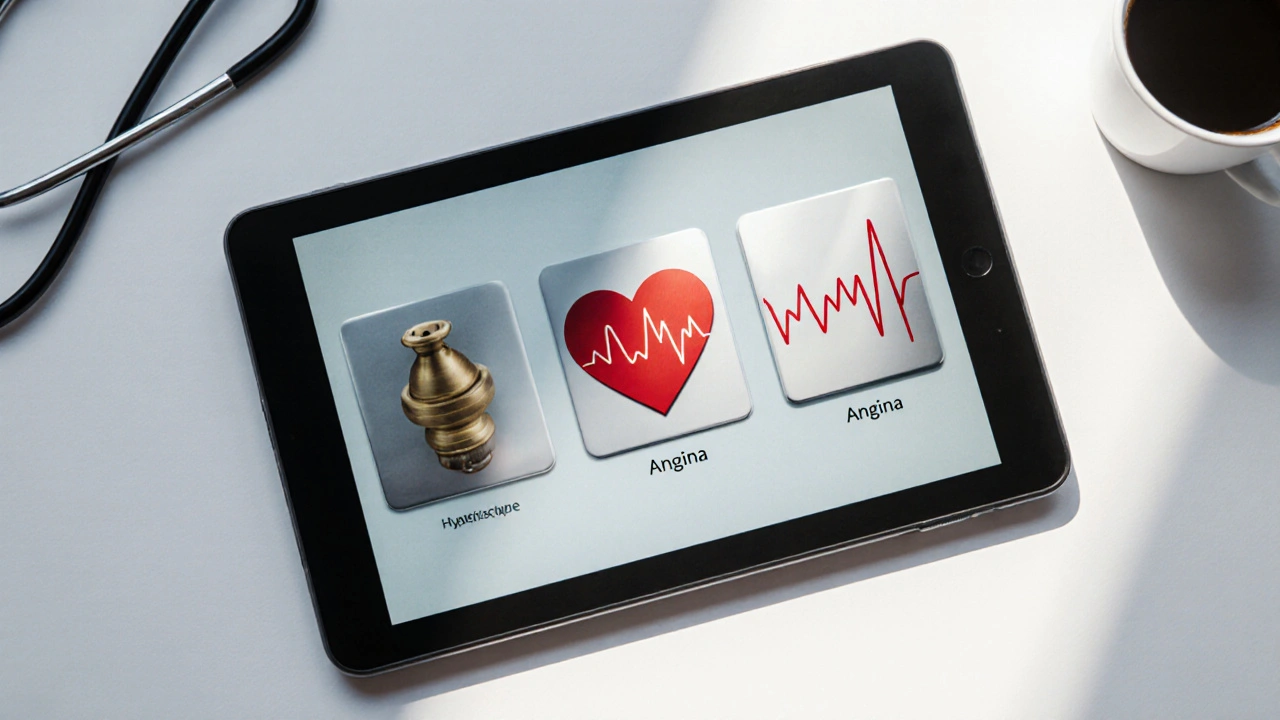Diltiazem vs Alternatives: Benefits, Risks & Best Uses

Diltiazem vs Alternatives Decision Guide
Select a medical condition below to see which medications are typically recommended for that condition:
Hypertension
High blood pressure management
Angina
Chest pain relief
Atrial Fibrillation
Heart rhythm control
Recommended Medications
Hypertension: Amlodipine or Lisinopril are often first-line choices. Diltiazem may be preferred if heart rate control is also needed.
Angina: Diltiazem or Verapamil are commonly prescribed due to their ability to reduce myocardial oxygen demand.
Atrial Fibrillation: Non-dihydropyridine calcium channel blockers (Diltiazem or Verapamil) are preferred for rate control.
Drug Comparison Table
| Drug | Primary Action | Best Indication | Typical Daily Dose | Key Side Effects |
|---|---|---|---|---|
| Diltiazem | Non-dihydropyridine calcium-channel blockade | Hypertension, angina, rate control for AF | 30-480 mg | Edema, headache, bradycardia, constipation |
| Amlodipine | Dihydropyridine calcium-channel blockade | Essential hypertension | 5-10 mg | Peripheral edema, flushing, gum overgrowth |
| Verapamil | Non-dihydropyridine calcium-channel blockade | Rate control for atrial fibrillation, angina | 80-480 mg | Constipation, AV block, negative inotropy |
| Metoprolol | Beta-1 selective blockade | Hypertension, post-MI, AF rate control | 50-200 mg | Bradycardia, fatigue, depression |
| Lisinopril | Angiotensin-converting enzyme inhibition | Hypertension, heart failure | 10-40 mg | Cough, hyperkalemia, angioedema |
Important Notes
- Individual responses vary; always consult your healthcare provider
- Consider comorbidities, age, and kidney function when choosing medication
- Drug interactions must be carefully reviewed before starting treatment
When doctors prescribe a heart‑related medication, patients often wonder if there’s a better option for their specific condition. Diltiazem is a well‑known calcium‑channel blocker, but it isn’t the only player on the field. Below we break down what Diltiazem does, compare it with the most common alternatives, and give you a quick decision guide for hypertension, angina, and rhythm problems.
What Is Diltiazem?
Diltiazem is a non‑dihydropyridine calcium‑channel blocker that relaxes smooth muscle in blood vessels and the heart. It lowers blood pressure, eases chest pain (angina), and can help control certain abnormal heart rhythms such as atrial fibrillation. First approved in the 1970s, the drug is available in immediate‑release tablets, extended‑release capsules, and IV formulations.
Key attributes:
- Mechanism: Inhibits L‑type calcium channels in vascular smooth muscle and cardiac nodal tissue.
- Typical dose: 30‑480mg per day, divided or once‑daily depending on formulation.
- Major uses: Hypertension, chronic stable angina, rate control for atrial fibrillation.
Common Alternatives to Diltiazem
Several other drugs target the same conditions, each with its own pros and cons. Below is a short snapshot of the most frequently considered alternatives.
- Amlodipine - a dihydropyridine calcium‑channel blocker that mainly dilates peripheral arteries, making it a go‑to for hypertension but less effective for heart‑rate control.
- Verapamil - another non‑dihydropyridine similar to Diltiazem, stronger at slowing the heart rate but with a higher chance of constipation and negative inotropic effects.
- Nifedipine - a rapid‑acting dihydropyridine often used for acute angina; extended‑release versions are also used for long‑term blood‑pressure control.
- Metoprolol - a beta‑blocker that reduces heart rate and contractility; useful when both hypertension and arrhythmia need to be managed.
- Lisinopril - an ACE inhibitor that lowers blood pressure by relaxing blood vessels; doesn’t help with chest pain directly but is heart‑protective.
How They Compare: Efficacy & Safety
| Drug | Primary Action | Best Indication | Typical Daily Dose | Key Side Effects |
|---|---|---|---|---|
| Diltiazem | Non‑dihydropyridine calcium‑channel blockade | Hypertension, angina, rate control for AF | 30‑480mg | Edema, headache, bradycardia, constipation |
| Amlodipine | Dihydropyridine calcium‑channel blockade | Essential hypertension | 5‑10mg | Peripheral edema, flushing, gum overgrowth |
| Verapamil | Non‑dihydropyridine calcium‑channel blockade | Rate control for atrial fibrillation, angina | 80‑480mg | d>Constipation, AV block, negative inotropy |
| Nifedipine | Dihydropyridine calcium‑channel blockade | Acute angina, hypertension | 30‑90mg (extended‑release) | Rapid BP drop, headache, reflex tachycardia |
| Metoprolol | Beta‑1 selective blockade | Hypertension, post‑MI, AF rate control | 50‑200mg | Bradycardia, fatigue, depression |
| Lisinopril | Angiotensin‑converting enzyme inhibition | Hypertension, heart failure | 10‑40mg | Cough, hyperkalemia, angioedema |
Overall, Diltiazem shines when you need a single drug that tackles both blood‑pressure and heart‑rate issues. If you only need to lower pressure without affecting the heart rate, Amlodipine or an ACE inhibitor might be cleaner choices. For pure rate control, Verapamil or Metoprolol could be preferred.

Choosing the Right Drug for Specific Conditions
Below is a quick decision map that matches the most common indications with the drug that typically offers the best balance of efficacy and tolerability.
- Essential Hypertension
- If you have no heart‑rate concerns, start with Amlodipine or Lisinopril.
- If you also need heart‑rate slowing (e.g., borderline AF), Diltiazem or Metoprolol are stronger options.
- Chronic Stable Angina
- First‑line: Diltiazem or Verapamil because they reduce myocardial oxygen demand.
- For patients who can’t tolerate calcium‑channel blockers, consider adding a low‑dose Beta‑blocker like Metoprolol.
- Atrial Fibrillation Rate Control
- Non‑dihydropyridine agents (Diltiazem or Verapamil) are preferred for rapid conversion and easy titration.
- If left‑ventricular dysfunction is present, a beta‑blocker (Metoprolol) may be safer.
Remember, drug choice also hinges on comorbidities, age, kidney function, and patient‑specific side‑effect tolerance.
Practical Tips & Common Pitfalls
- Check for drug interactions. Diltiazem and other calcium‑channel blockers can boost levels of statins (especially simvastatin) and some anti‑arrhythmics.
- Watch for edema. Peripheral swelling is more common with Diltiazem and amlodipine; dose reduction or adding a low‑dose diuretic often helps.
- Beware of bradycardia. Non‑dihydropyridines slow AV conduction; patients with baseline heart rates below 60bpm may need a lower dose or an alternative.
- Renal dosing. Most calcium‑channel blockers are safe in renal impairment, but ACE inhibitors like Lisinopril need dose adjustment.
- Pregnancy safety. Diltiazem is Category C; if you’re planning a pregnancy, discuss alternatives with your provider.
Key Takeaways
- Diltiazem offers dual control of blood pressure and heart rate, making it a versatile option for hypertension, angina, and atrial fibrillation.
- For pure hypertension without heart‑rate concerns, amlodipine or lisinopril are often better tolerated.
- Verapamil works similarly to Diltiazem but has a higher risk of constipation and negative heart‑muscle contractility.
- Beta‑blockers such as Metoprolol are preferred when left‑ventricular dysfunction coexists with rhythm problems.
- Always review drug‑interaction potential and monitor for edema, bradycardia, and cough (ACE inhibitors) when switching agents.
Frequently Asked Questions
Can I take Diltiazem with a statin?
Yes, but you should avoid high‑dose simvastatin. Diltiazem can raise statin levels, increasing the risk of muscle toxicity. Switching to pravastatin or rosuvastatin, or lowering the simvastatin dose, is recommended.
Is Diltiazem safe for people with asthma?
Diltiazem is generally safe because it does not block beta receptors. However, if you use a beta‑blocker for another condition, discuss the combination with your doctor.
What should I do if I develop leg swelling while on Diltiazem?
Notify your clinician. They may lower the dose, add a thiazide diuretic, or switch to an alternative like amlodipine (which can also cause edema but may be better tolerated at a lower dose).
Can Diltiazem be used during pregnancy?
It falls under FDA Category C, meaning risk cannot be ruled out. It should only be used if the potential benefits justify the risks. Discuss alternatives such labetalol or methyldopa with your obstetrician.
How quickly does Diltiazem start working for angina?
Immediate‑release tablets can begin relieving chest pain within 30‑60 minutes, while extended‑release forms achieve steady control over several days.

20 Comments
Wow, this guide totally flips the script on my whole med‑stack!
In the grand tapestry of cardiovascular pharmacotherapy, Diltiazem occupies a uniquely ambivalent niche, simultaneously celebrated for its dual vasodilatory and negative dromotropic properties while castigated for its propensity to engender peripheral edema and sinus bradycardia. Its non‑dihydropyridine classification distinguishes it from agents such as Amlodipine, conferring a more pronounced effect on nodal tissue. Clinicians often gravitate toward Diltiazem when tasked with concomitant hypertension and rate‑control in atrial fibrillation, a scenario wherein the drug’s capacity to attenuate calcium influx through L‑type channels proves advantageous. Nevertheless, the pharmacokinetic labyrinth of Diltiazem, characterized by extensive hepatic metabolism via CYP3A4, begets a litany of drug‑drug interactions that can precipitate toxic serum concentrations of co‑administered statins or anti‑arrhythmics. Moreover, its relatively modest impact on peripheral vascular resistance renders it less potent than pure vasodilators in isolated hypertensive cohorts. The comparative efficacy data, while robust in certain meta‑analyses, remain heterogenous, reflecting divergent study designs, dosing regimens, and patient populations. From a safety standpoint, the incidence of edema parallels that of dihydropyridine calcium channel blockers, yet the mechanistic underpinnings differ, implicating capillary hydrostatic pressure fluctuations rather than pure arteriolar dilation. Contraindications extend beyond overt heart block to include severe hepatic impairment, wherein first‑pass metabolism is substantially compromised. In the therapeutic algorithm, Diltiazem often cedes ground to beta‑blockers such as Metoprolol when left‑ventricular dysfunction coexists, given the latter’s favorable mortality benefit. Conversely, in patients intolerant to beta‑blockade due to reactive airway disease, Diltiazem stands as a viable alternative. The decision matrix thus pivots on a delicate balance of comorbidities, tolerability, and individual pharmacogenomic profiles. Ultimately, the clinician must weigh the drug’s versatile hemodynamic modulation against its interaction profile and adverse event spectrum, tailoring therapy to the nuanced physiologic demands of each patient.
Diltiazem is fine but the side‑effects list reads like a horror movie.
Sure, Diltiazem does the job, but if you enjoy juggling drug interactions, go ahead – it pairs beautifully with a statin overdose.
Indeed, the comparative table, while aesthetically pleasing, fails to address the nuances of renal clearance – particularly in patients with stage‑3 CKD. One must consider dose adjustment, something the author omits.
This is the kind of medical drama we live for!
Oh, absolutely – because nothing says “I trust my cardiologist” like a drug that can double your simvastatin levels 😏.
The guide does a solid job of laying out the options without leaning toward any particular brand, which is refreshing.
Everyone seems to have a favorite, but at the end of the day it’s about matching the drug to the patient’s whole health picture.
It is noteworthy that the pharmacokinetic profile of Diltiazem differs markedly between its immediate‑release and extended‑release formulations.
When we talk about calcium‑channel blockade, we’re really discussing the modulation of L‑type channels, which impacts both vascular tone and atrioventricular nodal conduction.
True, but remember that the heart’s rhythm is a metaphor for life’s cadence; a drug that steadies it can also dull the exhilarating spikes we sometimes crave.
Sounds like you’ve been through a lot with side‑effects – sending virtual hugs your way 😊.
Behold! The saga of Diltiazem versus its rivals unfolds, each vying for the throne of cardiac supremacy.
While the overview is commendable, one must underscore the role of CYP3A4 metabolism; ignoring this can precipitate toxic plasma concentrations 🤓.
What’s really hidden is the pharma lobby’s subtle push to keep Diltiazem in the spotlight, ensuring generic profits stay stagnant.
Let’s stay hopeful – with careful monitoring, any of these agents can be tailored safely to the individual.
Honestly, if you’re still citing basic calcium‑channel mechanisms, you’re missing the bigger picture of downstream signaling pathways.
Great summary! Remember, patient education is key – empowering them with knowledge about potential edema or bradycardia can improve adherence.
Diltiazem? Overrated hype, plain and simple.